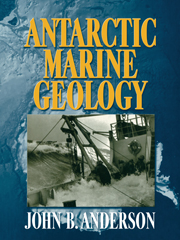Book contents
CHAPTER 2 - Geologic History of Antarctica
Published online by Cambridge University Press: 06 December 2010
Summary
Antarctica is ∼ 14,200,000 km2 in area, larger than the combined areas of the United States and Mexico, and consists of two major continental blocks. East Antarctica is a large stable continental craton composed mainly of Precambrian metamorphic basement rocks with granitic intrusions that are unconformably overlain by generally flat-lying sedimentary rocks. In contrast, West Antarctica is an archipelago of several microplates with mountainous metamorphic and volcanic terranes. The TAM, one of the major mountain chains of the Earth, mark the boundary zone between East and West Antarctica (Fig. 2.1).
Our geologic knowledge of Antarctica is limited, because an ice sheet averaging 1 to 4 km in thickness covers 98% of the continent. The subglacial topography of the continent is reasonably well-known, due to airborne radioecho sounding technology. Subglacial topographic maps show that vast portions of the continent lie below sea level. Much of the land would remain below sea level if the ice sheet were to melt and the continent to rebound isostatically (Fig. 1.2). These subglacial basins are part of the Antarctic marine geologic realm.
Given the paucity of outcrops on Antarctica and drill sites on the continental margin, information about the geologic history of the continent draws heavily on published descriptions of strata from contiguous Gondwana continents. This information is used to create a framework for predicting stratigraphic successions that should occur within marine and subglacial basins in Antarctica. This chapter is a summary of the geologic history of Antarctica in the context of its association with other Gondwana continents. It is intended as a reference chapter to provide information about how various portions of the continent and its margin evolved.
- Type
- Chapter
- Information
- Antarctic Marine Geology , pp. 28 - 57Publisher: Cambridge University PressPrint publication year: 1999
- 1
- Cited by



